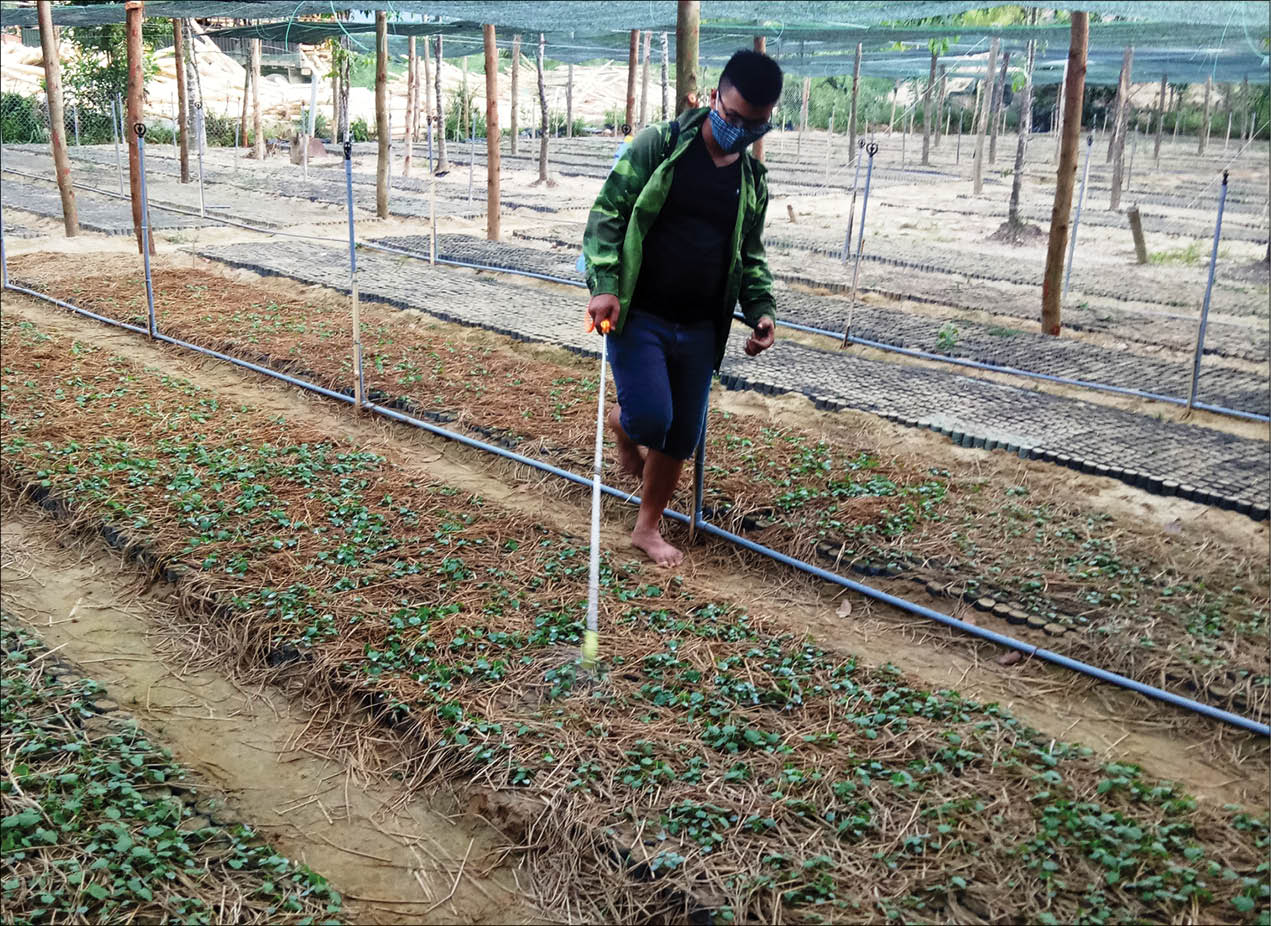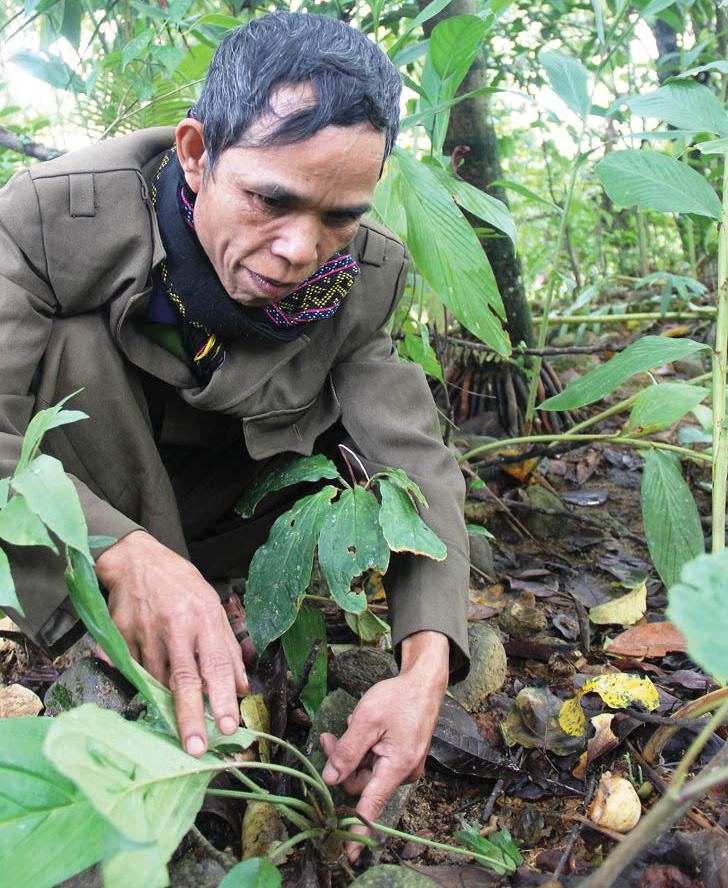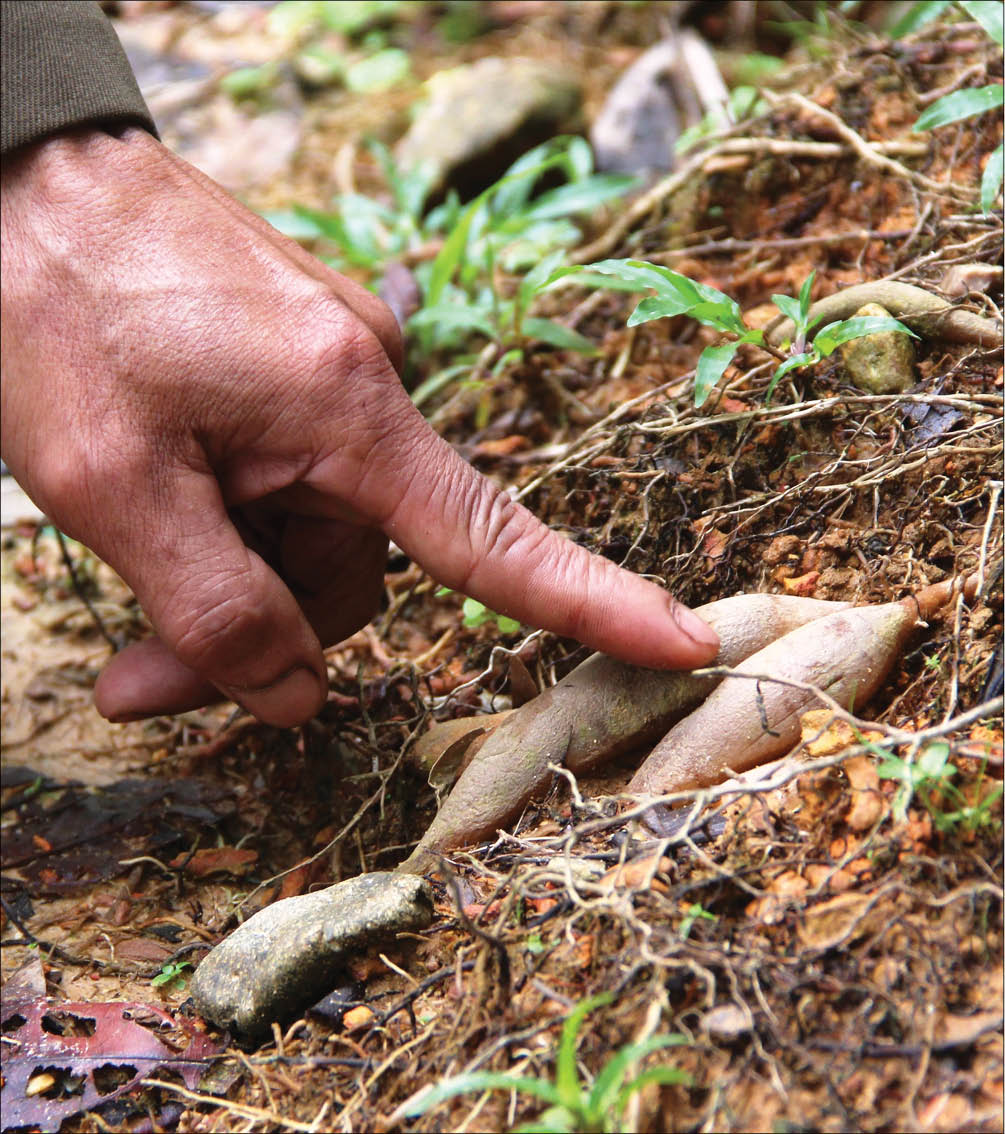
Bo Chinh Ginseng Nursery in A Luoi
After the hunts for a “panacea”
Along the legendary Ho Chi Minh route, it is not difficult to find the scene of trade in the varieties of medicinal herbs sought by upland people in the faraway forests.
For about 5 years now, upland medicinal herbs have been popular in the plain. The uses of some herbs have been scientifically proven, but those of many others have been known of merely by rumors.
Mrs. Vien Thi Ngo (Bac Son Commune, A Luoi District) spread the tarpaulin covered with dust on the sidewalk of Ho Chi Minh Road, rushing to pour the medicinal herbs from the papoose gathered by her husband and children throughout the week in the far-off forest. Momentarily, about 3kg of medicinal herbs were asked to buy by customers.
“It is a stork-neck green lim mushroom, a medicinal herb very popular in the plain at a price of VND 2.5 million per dry kg. Among the varieties of mushrooms, that is the dearest and rarest. To pick this variety of mushroom, my husband and son had to try very hard;they had to went as far as the forest area bordering on Laos,” Ms. Ngo shared.

A variety of ginseng acclimated by Mr. Kha
“In A Luoi, a great many people go to the forest to pick green lim mushroom. In the past, when the source of mushrooms was plentiful, each day a few pounds could be picked, but now many people are rushing to pick, so mushrooms are exhausted," Ngo said.
Medicinal herbs increasingly run out, but strangely enough, everyday along the routes through the mountain are regular buyers and sellers. To clarify the source of the story, I went and saw Mr. Ho Xuan Kha (aged 60, A So 2 Hamlet, Huong Lam Commune, A Luoi District).
Mr. Kha is a famous medicinal herb hunter in A Luoi Uplands. Not now, but about three decades ago, he was well-known for his forest searches for medicinal leaves. Through the conversation with him, I know that the search for upland herbs was as old as the hills, and there are also “whether-to-laugh-or-cry” stories behind the ginseng, the medicinal leaves sought all over the forests
“If gold is not rare, is it valuable? If medicinal herbs are not valuable, are there a lot of buyers? ”Mr. Kha said before starting the story of the forest search for “green gold”
Mr. Kha talked about Ngoc Linh's once-known first ginseng in A Luoi mountain and forest. At that time, through the words in their ears, the villagers knew vaguely about the "panacea" from the remote mountainous area of Quang Nam Province, which could be compared with the high-class Korean ginseng.
Then they rushed into the remote forest for several months on end to search for Ngoc Linh ginseng; some had accidents on the way, even lost their life. The result after many forest searches facing the danger was a few ginseng tubers the people assumed those to be Ngoc Linh ginseng.
"A Luoi people have not yet directly seen Ngoc Linh ginseng. They only heard rumors about the shape of ginseng and then went into the forest to search. Finding ginseng, they concealed it very carefully and absolutely failed to let anyone see. Only when there are giants or traders setting a high price do they take ginseng out. However, afterwards that ginseng was identified merely as a common variety of tree root. Although regretful, they threw it away,” Mr. Kha revealed.

Mr. Kha with medicinal herbs grown in his own garden
Before becoming a medicinal herbal hunter, Mr. Kha was instructed by his ancestors in the uses and ways of identifying medicinal leaves. Now, in the small garden behind his house, many precious medicinal herbs are preserved. He considers it a valuable achievement after more than half a life of the forest search for herbal medicine.
“To pluck medicinal leaves, it is absolutely necessary to know the identification and testing methods because many varieties of leaves contain extremely powerful toxins. Some medicinal herbs are of high value, but not everyone knows. Currently, the people thoroughly know many varieties such as Lingzhi mushrooms, green lim mushrooms, natural Pakit ginseng, so the ginseng and mushroom resources of A Luoi forest and mountain have been gradually exhausted. The varieties sold by villagers along the road are mostly not sought from A Luoi mountain and forest but in remote Lao mountain villages,” said Kha.

Lingzhi mushrooms are on sale along Ho Chi Minh Road
"Ginseng offered to the king" starts its attachment to A Luoi Uplands
Throughout thousands of years of natural selection, precious plants have existed among A Luoi mountain and forest as a testament to the great economic potential under the forest canopy. People are depleting the forest resources but still cherishing the dream of the fields of medicinal herbs right under the forest canopy, where they often "lean back" every day.
If there is no value, not many villagers will try their hardest to seek medicinal herbs despite the danger. In A Luoi, the habit of living by makeshifts is still deeply ingrained in the majority of people’s mind even though some people like to collect precious plants and acclimate those right on their own gardens.
Mr. Tran Ngoc Chinh, Deputy Head of Agriculture and Rural Development Division of A Luoi District talked about the project "The Greater Mekong Sub-region's Biodiversity Conservation Corridor, Phase 2" (BCC project) supporting the people in upland communes in growing purple Pakit ginseng under the forest canopy to pave the way for them to find new directions.
“Whether to succeed or not remains unknown; Pakit purple ginseng has been grown by people for about 2 years and is under good development. In Vietnam, currently up to 75% of the pharmaceutical materials have to be imported, so the output potential renders this project very promising,” Chinh informed.
In addition to Pakit ginseng, Mr. Chinh listed a series of precious plants that survive in the mountainous region to prove the value and potential of upland medicinal herbs including dozens of varieties of lingzhi mushrooms, green lim mushrooms and rare gynostemma pentaphyllum. And he revealed the 5-hectare garden planted with Bo Chinh ginseng - one of the four best ginseng varieties in Vietnam, once Quang Binh people used to offer to the kings in the Nguyen Court.
To introduce this variety of ginseng to A Luoi land, Chinh went as far as Dong Thap to buy seedlings. Previously, after many years of studying the local climate and soil, he thought that this land was suitable for the “ginseng offered to the king".
“Our Bo Chinh Ginseng Garden is in good development. 50,000 seedlings are planted, promising to offer new prospects and generate high income. We also signed the contract to purchase the products at market price for 3 years with a partner in the South. Each year, about 60 tons of ginseng must be supplied. If successful, this model will be expanded for people to improve economic efficiency,” Mr. Chinh said.
“Development of medicinal herbs under forest canopy not only contributes to biodiversity conservation but also makes people aware of forest protection. The linkage and complementarity between forests and medicinal herbs create a sustainable direction. The idea of "growing ginseng ... against deforestation", which started and was put into practice, shows effectiveness. Once people see the economic efficiency from this model, there will be dual benefit,” Mr. Chinh shared.
Story and photos: Le Tho